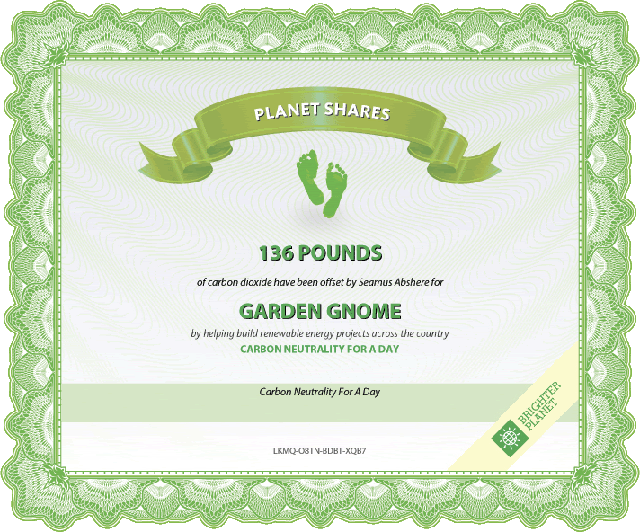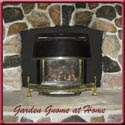Neighbours talking over the garden gate has long been a tradition. They share gardening tips, complain about the weather and pests yet are ever eager to discuss their gardens. That is what I had in mind when creating this blog. So stop by my garden gate to find out the latest happenings in my garden.
Happy Gardening!
Garden Gnome
"All my life through, the new sights of Nature made me rejoice like a child." ~ Madame Marie Curie"
In rural communities, windbreaks are a common scene and for good reason. They slow the wind down or prevent prevailing winter winds from hitting your house directly saving valuable heating dollars. In the summer they slow or prevent soil erosion. In the heat of the summer deciduous windbreaks help to cool winds before they reach your house. Some windbreaks provide a habitat for small birds that help in insect control as well. Every house can benefit from the proper use of windbreaks but you have to understand how the prevailing winds are affecting your home.
 One Windbreak
One Windbreak
Our house is very well shielded with both evergreen and deciduous windbreaks on all four sides. The entire property is bordered by smaller almost 3' high evergreens and boxwoods on three and a half sides as well as bordering the laneway. Pictured is the larger evergreens that form a portion of part of a portion of the one side. This is side is the most open but the neighbours trees in the background serve as a windbreak as well. Towards the base of the large evergreen you can just barely see the water's edge. This side does not need as much of a windbreak because if the wind is coming from that direction it is from the south, something rather desirable in the winter months because it is a warmer wind. Just barely showing to the right is a large maple tree that provides a windbreak to the upper level during the summer. In line with that tree is a shorter windbreak of evergreens to the water's edge. Along the water's edge is another windbreak of boxwoods that cool the summer west winds but allow the winter winds warmed by the water through. The north side is fully protected to block as much of the winter north winds as possible.
 Physics of Windbreaks
Physics of Windbreaks
A windbreak is essentially vegetation or fencing or any other obstacle meant to slow down the velocity of the wind. The wind hits the windbreak then is forced to go around creating a blocked area on the other side of the windbreak with no wind. A distance from this area the wind will swirl together again. In essence buildings are quite effective windbreaks but for energy efficiency you want windbreaks to slow the amount of wind from reaching the building directly. Properly placed windbreaks can direct the winter prevailing winds away from houses and laneways effectively directing blowing snow from these areas. At the same time they can prevent winds from reaching the house almost entirely. For example if you plant a row of thick evergreens 2 to 3 feet tall along the northern wall of your house with a crawlspace it will greatly increase the energy efficiency and comfort level of that wall because the wind is blocked.
Effective windbreaks include: corn stubble, tall grasses, tall and short evergreens, deciduous trees, living walls. living privacy screening and of course wood fences. Wherever possible try to use living windbreaks as they give back to the environment. When establishing windbreaks pay attention to the winds you want to block in the season you want to block them. In the northern hemisphere that will mean blocking the north and northwesterly winds in the winter. For lower areas and directly abutting your house use lower growing, dense evergreen shrubs. To slow winds before they get to your house use taller evergreen and deciduous depending on what winds you want to control.
Happy Gardening!
Garden Gnome
©2006-2008


Happy Gardening!
Garden Gnome
©2006-2008

It's that time of year for the most popular holiday icon to make its presence. A decorated Christmas tree is a must have for many. In years past that meant going out and cutting your own tree. In recent times it means pulling the artificial tree from the closet and setting it up. Either way the Christmas tree is a seasonal tradition. There are definite reasons for choosing a real Christmas tree over an artificial tree if at all possible. The pros and cons of using either follow.
Artificial Christmas Trees
Pros
- artificial trees are inexpensive and can be re-used for several years
- they work well for those living in apartments where there may be restrictions
- they eliminate allergy concerns for those sensitive to evergreens or other allergens they may harbour
- they are essentially mess free
Cons
- many of these trees are petroleum based produced
- they collect dust that can also be an allergen for some
- they do not contribute anything positive to the environment during production or use
Real Christmas TreesPros
- these trees are grown on tree farms so are a cash crop helping to support those who grow them
- buying locally means you are not adding to your carbon footprint
- real trees help clean the air and provide oxygen during the time they are growing and they continue both while being used as a Christmas tree
- they are natural air fresheners
- for those with wood stoves or fireplaces the trees can be used for heat
- they can be recycled through municipal pick-up or composting
Cons- real trees can harbour allergens including the possibility to that particular variety of evergreen itself
- they can harbour insects
- they can be messy
In terms of environmental concerns a live tree is superiour to an artificial tree. Many nurseries are now selling potted live Christmas trees that can be decorated for the season then kept to plant when the weather turns nice. I know everyone has favourite decorations for their trees but consider going for an old fashioned approach using popcorn and cranberries to make garland. Cinnamon dough decorations will give a wonderful holiday scent while decorating your tree and they can be put in the compost bin when you no longer need them. Homemade beeswax ornaments, lace ornaments and other home crafted ornaments can give your tree a lovely look and feel. To make your tree choice more environmentally friendly if you decide to light it up use the new LED lights that will use the minimal amount of energy to light up your tree.
Happy Gardening!
Garden Gnome
©2006-2008

You cannot imagine how surprised I was to see this certificate saying I was
carbon neutral for a day! Our carbon footprint is something that we have been actively reducing for quite some time. We do this by growing as much as we can organically and reducing our consumption in all areas of our lives. With each house we have learned more so we have been able to fine tune to a higher level and much quicker. I happy to say our recent energy audit for this house came in at almost half that of other homes in our area (write-up
here) but there is still room for improvement.
Every person who takes the time and energy to grow any portion of their food is reducing their carbon footprint. The more you grow the more you are reducing your carbon footprint as well as providing fresh produce for well under the price of even produce bought from the farmer's markets. It is surprising at how much produce can be grown in small spaces, in containers and indoors. It is also surprising how little effort growing your own food can be. Gardening is beneficial on so many levels. Sure you get the produce and that lowers your food costs but there are health benefits. Gardening sooths the soul, lowers your blood pressure, gives you fresh air and exercise. At the same time gardening keeps your brain active and gives you a greater appreciation for the environment.
During this holiday season I would like to gift the first 25 people who click
here in support to fight climate change with one carbon neutral day. This generous gift is donated by
Brighter Planet. So please click the link and get your own carbon neutral day.
Happy Gardening!
Garden Gnome
©2006-2008
 One Windbreak
One Windbreak Physics of Windbreaks
Physics of Windbreaks





















